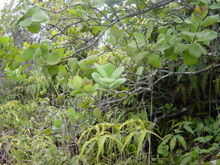Santalum
| Santalum | |
|---|---|

| |
| The branches of a young Santalum paniculatum on the island of Hawaiʻi | |
| Scientific classification | |
| Kingdom: | Plantae |
| Clade: | Tracheophytes |
| Clade: | Angiosperms |
| Clade: | Eudicots |
| Order: | Santalales |
| Family: | Santalaceae |
| Genus: | Santalum L. |
| Species | |
|
See text | |
| Synonyms[1] | |
| |
Santalum is a genus of woody
Indian sandalwood (S. album) is found in the
Santalum species are used as food plants by the larvae of some Lepidoptera species, including Endoclita malabaricus.
Cultivation
The initial challenges to cultivating Santalum are numerous, not only due to its germination and growth needs, but also the amount of growing time required for the tree to properly mature. Germination of Santalum seeds is not completely understood. Seeds cannot be effectively stored, and must be planted upon harvesting them from a fruiting tree. Even in doing this, the seeds may not germinate. As such, growing saplings can be quite labour-intensive.
Furthermore, although Santalum trees
To produce commercially valuable sandalwood with high levels of fragrance oils, the trees have to be at least 40 years of age, but 80 or above is preferred. As such, those who begin cultivation of Santalum likely will not live to reap the rewards of their work. However, inferior sandalwood that has been cut or toppled at 30 years old can still fetch a decent price due to the demand for real sandalwood.
Beyond these initial difficulties, growing sandalwood is not difficult, since it becomes more resistant to environmental stresses, pests, and diseases as it matures.
Sandalwood is often cited as one of the most expensive woods in the world, along with African blackwood, pink ivory, agarwood and ebony.[2][3]
Species
19 species are currently accepted:[1]
- A.DC. — desert quandong, sweet quandong, native peach (Australia)
- S. album L. — Indian sandalwood, white sandalwood, chandana (India, Indonesia, northern Australia)
- S. austrocaledonicum Vieill. (New Caledonia, Vanuatu)[4]
- S. boninense (Nakai) Tuyama (Bonin Islands, Japan)
- S. ellipticum Gaudich. — ʻiliahialoʻe, coast sandalwood (Hawaiʻi)[5]
- Phil. (Juan Fernández Islands)
- S. freycinetianum Gaudich. — ʻiliahi (Hawaiʻi)[6][7]
- S. haleakalae Hillebr. — ʻiliahi (Hawaiʻi)
- A.DC.(south-central Pacific)
- H.St.John(Hawaiian Islands (Kauai))
- R.Br.— northern sandalwood (Australia)
- S. macgregorii F.Muell (Papua New Guinea, Indonesia)
- C.A.Gardner— bitter quandong (Australia)
- S. obtusifolium R.Br. (Australia)
- Arn.— ʻiliahi (Hawaiʻi)
- S. papuanum Summerh. (New Guinea)
- S. pyrularium A.Gray (Hawaiian Islands (Kauai))
- A.DC.— Australian sandalwood (Australia)
- S. yasi Seem. - yasi (Fiji, Niue) Tonga- Ahi [8]
Formerly placed here
- Mida salicifolia A.Cunn. — willowleaf sandalwood (as S. salicifolium (A.Cunn.) Meurisse)
Etymology
Santalum derives its name from the Greek santalon, in turn from the Arabic sandal, in turn from Sanskrit chandana (Indian sandalwood).[9]
References
- ^ a b Santalum L. Plants of the World Online. Retrieved 12 November 2023.
- ^ "Top 10 Most Expensive Woods in the World". Salpoente Boutique. 18 November 2016. Retrieved 19 September 2020.
- ^ "11 Most Expensive Woods in the World". Ventured. 22 July 2020. Retrieved 19 September 2020.
- ^ "Santalum austrocaledonicum". Germplasm Resources Information Network. Agricultural Research Service, United States Department of Agriculture. Retrieved 2009-04-05.
- ^ Little Jr., Elbert L.; Roger G. Skolmen (1989). "ʻiliahi-a-lo e, coast sandalwood" (PDF). United States Forest Service.
{{cite journal}}: Cite journal requires|journal=(help) - ^ Little Jr., Elbert L.; Roger G. Skolmen (1989). "ʻIliahi, Freycinet sandalwood" (PDF). United States Forest Service.
{{cite journal}}: Cite journal requires|journal=(help) - ^ Allen, James A. (2003-01-01). "Santalum freycinetianum Gaudich". Tropical Tree Seed Manual. Reforestation, Nurseries & Genetics Resources. Archived from the original (PDF) on January 16, 2009. Retrieved 2009-03-01.
- ^ "Santalum yasi". Germplasm Resources Information Network. Agricultural Research Service, United States Department of Agriculture. Retrieved 2009-04-05.
- ^ Western Australian Herbarium, Biodiversity and Conservation Science. "Florabase—the Western Australian Flora". florabase.dbca.wa.gov.au. Retrieved 2023-12-06.
- "Santalum L." Australian Plant Name Index (APNI), IBIS database. Centre for Plant Biodiversity Research, Australian Government.
- "Santalum L." Department of Biodiversity, Conservation and Attractions.
External links
- Australian Quandong Industry Association
- Australian Plants online: Santalum
- Hawaiian Native Plants: Santalum
- Merlin, Mark D.; Lex A.J. Thomson; Craig R. Elevitch (April 2006). "Santalum ellipticum, S. freycinetianum, S. haleakalae, and S. paniculatum (Hawaiian sandalwood)" (PDF). The Traditional Tree Initiative.
{{cite journal}}: Cite journal requires|journal=(help) - "ʻIliahi". Native Hawaiian Plants. Kapiʻolani Community College.
- Thomson, Lex A. J. (April 2006). "Santalum austrocaledonicum and S. yasi (sandalwood)" (PDF). The Traditional Tree Initiative.
{{cite journal}}: Cite journal requires|journal=(help)
